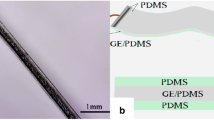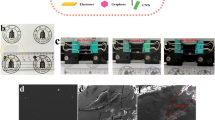Abstract
To date, wearable sensors are increasingly finding their way into application of healthcare monitoring, body motion detection and so forth. A stretchable and wearable strain senor was fabricated on the basis of commercially available spandex/nylon fabric by the integration of conductive graphene network. Specifically, a simple graphene oxide dip-reduce method that enabled scalable fabrication pathway was employed. The good recovery of the graphene-coated fabric led to consistent resistance values despite the strain applied on the fabric and exhibited high gauge factor around 18.5 at 40.6% strain. Moreover, the graphene-coated fabric sensor could detect human motions such as finger bending with acceptable mechanical properties against un-coated fabrics, indicating that it has huge potential in wearable sensors applications.







Similar content being viewed by others
References
Trung TQ, Lee N-E (2016) Flexible and stretchable physical sensor integrated platforms for wearable human-activity monitoring and personal healthcare. Adv Mater 28(22):4338–4372. https://doi.org/10.1002/adma.201504244
Kang HG, Mahoney DF, Hoenig H, Hirth VA, Bonato P, Hajiar I, Lipsitz LA (2010) In situ monitoring of health in older adults: technologies and issues. J Am Geriatr Soc 58(8):1579–1586
Paradiso R, Loriga G, Taccini N (2004) Wearable system for vital signs monitoring. Stud Health Technol Inform 108:253–259
Teng X-F, Zhang Y-T, Poon CCY, Bonato P (2008) Wearable medical systems for p-Health. IEEE Rev Biomed Eng 1:62–74
Webb RC, Bonifas AP, Behnaz A, Zhang Y, Yu KJ, Cheng H, Shi M, Bian Z, Liu Z, Kim YS, Yeo WH, Park JS, Song J, Li Y, Huang Y, Gorbach AM, Rongers JA (2013) Ultrathin conformal devices for precise and continuous thermal characterization of human skin. Nat Mater 12(10):938–944. https://doi.org/10.1038/nmat3755
Amjadi M, Kyung K-U, Park I, Sitti M (2016) Stretchable, skin-mountable, and wearable strain sensors and their potential applications: a review. Adv Funct Mater 26(11):1678–1698. https://doi.org/10.1002/adfm.201504755
Wang Y, Wang L, Yang T, Li X, Zang X, Zhu M, Wang K, Wu D, Zhu H (2014) Wearable and highly sensitive graphene strain sensors for human motion monitoring. Adv Funct Mater 24(29):4666–4670. https://doi.org/10.1002/adfm.201400379
Yeo WH, Kim YS, Lee J, Ameen A, Shi L, Li M, Wang S, Ma R, Jin SH, Kang Z, Rongers JA (2013) Multifunctional epidermal electronics printed directly onto the skin. Adv Mater 25(20):2773–2778. https://doi.org/10.1002/adma.201204426
Amjadi M, Pichitpajongkit A, Lee S, Ryu S, Park I (2014) Highly stretchable and sensitive strain sensor based on silver nanowire-elastomer nanocomposite. ACS Nano 8(5):5154–5163. https://doi.org/10.1021/nn501204t
Choong C-L, Shim M-B, Lee B-S, Jeon S, Ko D-S, Kang T-H, Bae J, Lee SH, Bryun K-E, Im J, Jeong YJ, Park C, Park J-J, Chung U-I (2014) Highly stretchable resistive pressure sensors using a conductive elastomeric composite on a micropyramid array. Adv Mater 26(21):3451–3458. https://doi.org/10.1002/adma.201305182
Muth JT, Vogt DM, Truby RL, Kolesky DB, Wood RJ, Lewis JA et al (2014) Menguc Y. Adv Mater 26(36):6307–6312. https://doi.org/10.1002/adma.201400334
Shin MK, Oh J, Lima M, Kozlov ME, Kim SJ, Baughman RH (2010) Elastomeric conductive composites based on carbon nanotube forests. Adv Mater 22(24):2663–2667. https://doi.org/10.1002/adma.200904270
Voyce J, Dafniotis P, Towlson S (2005) Textiles in sport. Woodhead Publishing, UK
Chattopadhyay R, Gupta D, Bera M (2012) Effect of input tension of inlay yarn on the characteristics of knitted circular stretch fabrics and pressure generation. J Text I 103:636–642. https://doi.org/10.1080/00405000.2012.665237
Needles HL (1981) Handbook of textile fibers, dyes, and finishes. Garland STPM Press, New York
Hepburn C (1982) Polyurethane elastomers. Applied Science Publishers, UK
Hughes AJ, McIntyre JE, Clayton G, Wright P, Poynton DJ, Atkinson J, Morgan PE, Rose L, Stevenson PA, Mohajer AA, Ferguson WJ (1976) The production of man-made fibres. Text Prog 8(1):1–156. https://doi.org/10.1080/00405167608688984
Maziz A, Concas A, Khaldi A, Stålhand J, Persson N-K, Jager EWH (2017) Knitting and weaving artificial muscles. Sci Adv 3:e1600327. https://doi.org/10.1126/sciadv.1600327
Atalay O, Kennon W, Husain M (2013) Textile-based weft knitted strain sensors: effect of fabric parameters on sensor properties. Sensors 13(8):11114–11127. https://doi.org/10.3390/s130811114
Zhang J, Yang H, Shen G, Cheng P, Zhang J, Guo S (2010) Reduction of graphene oxide vial-ascorbic acid. Chem Commun 46:1112–1114. https://doi.org/10.1039/B917705A
Li X, Chen Y, Kumar A, Mahmoud A, Nychka JA, Chung H-J (2015) Sponge-templated macroporous graphene network for piezoelectric ZnO nanogenerator. ACS Appl Mater Interfaces 7(37):20753–20760. https://doi.org/10.1021/acsami.5b05702
ASTM D2594-04 (2004) Standard test method for stretch properties of knitted fabrics having low power. ASTM International, West Conshohocken
ASTM D1776-04 (2004) Standard practice for conditioning and testing textiles. ASTM International, West Conshohocken
Patnaik A, Rengasamy RS, Kothari VK, Ghosh A (2006) Wetting and wicking in fibrous materials. Text Prog 38:1–105. https://doi.org/10.1533/jotp.2006.38.1.1
Yun YJ, Hong WG, Kim W-J, Jun Y, Kim BH (2013) A novel method for applying reduced graphene oxide directly to electronic textiles from yarns to fabrics. Adv Mater 25(40):5701–5705. https://doi.org/10.1002/adma.201303225
Chen S, Wei Y, Yuan X, Lin Y, Liu L (2016) A highly stretchable strain sensor based on a graphene/silver nanoparticle synergic conductive network and a sandwich structure. J Mater Chem C 4:4304–4311. https://doi.org/10.1039/C6TC00300A
Yan C, Wang J, Kang W, Cui M, Wang X, Foo CY, Chee KJ, Lee PS (2014) Highly stretchable piezoresistive graphene-nanocellulose nanopaper for strain sensors. Adv Mater 26(13):2022–2027. https://doi.org/10.1002/adma.201304742
Tian H, Shu Y, Cui Y-L, Mi W-T, Yang Y, Xie D, Ren T-L (2014) Scalable fabrication of high-performance and flexible graphene strain sensors. Nanoscale 6:699–705. https://doi.org/10.1039/C3NR04521H
Cai G, Yang M, Xu Z, Liu J, Tang B, Wang X (2017) Flexible and wearable strain sensing fabrics. Chem Eng J 325:396–403. https://doi.org/10.1016/j.cej.2017.05.091
Wang J, Xue P, Tao X, Yu T (2014) Strain sensing behavior and its mechanisms of electrically conductive PPy-coated fabric. Adv Eng Mater 16(5):565–570. https://doi.org/10.1002/adem.201300407
Lee C, Wei X, Kysar JW, Hone J (2008) Measurement of the elastic properties and intrinsic strength of monolayer graphene. Science 321(5887):385–388
Ramanathan T, Abdala AA, Stankovich S, Dikin DA, Herrera-Alonso M, Piner RD, Adamson DH, Schniepp HC, Chen X, Ruff RS, Nguyen ST, Aksay IA, Prud’Homme RK, Brinson LC (2008) Functionalized graphene sheets for polymer nanocomposites. Nat Nano 3:327–331. https://doi.org/10.1038/nnano.2008.96
Acknowledgements
We acknowledge the NSERC RGPIN 435914 for financial support of this work.
Authors contribution
HL, MG, HC and YC conceived ideas. HL, MG and XL performed experiments. XL and HC established graphene reduction protocols. HL and MG wrote manuscript. All authors have given approval to the final version of the manuscript.
Author information
Authors and Affiliations
Corresponding author
Ethics declarations
Conflict of interest
The authors declare that there is no conflict of interest regarding the publication of this paper.
Electronic supplementary material
Below is the link to the electronic supplementary material.
Rights and permissions
About this article
Cite this article
Lee, H., Glasper, M.J., Li, X. et al. Preparation of fabric strain sensor based on graphene for human motion monitoring. J Mater Sci 53, 9026–9033 (2018). https://doi.org/10.1007/s10853-018-2194-7
Received:
Accepted:
Published:
Issue Date:
DOI: https://doi.org/10.1007/s10853-018-2194-7




